University Accounting Assignment Solution: ADM 2342
VerifiedAdded on 2022/08/23
|9
|1042
|31
Homework Assignment
AI Summary
This accounting assignment solution covers a range of topics including journal entries for various transactions such as revaluation of land, purchase and depreciation of warehouse equipment, adjustments for asset disposal, and impairment losses on patents. It also includes journal entries related to investments in equity shares and debt securities, recording dividends, interest income, and revaluation gains and losses. Furthermore, the assignment features a memo explaining three depreciation methods: the straight-line method, the written-down value method, and the sum-of-the-years-digits method, along with their advantages and disadvantages. The memo provides recommendations on which method is most suitable for a specific scenario and concludes with a bibliography of relevant sources.
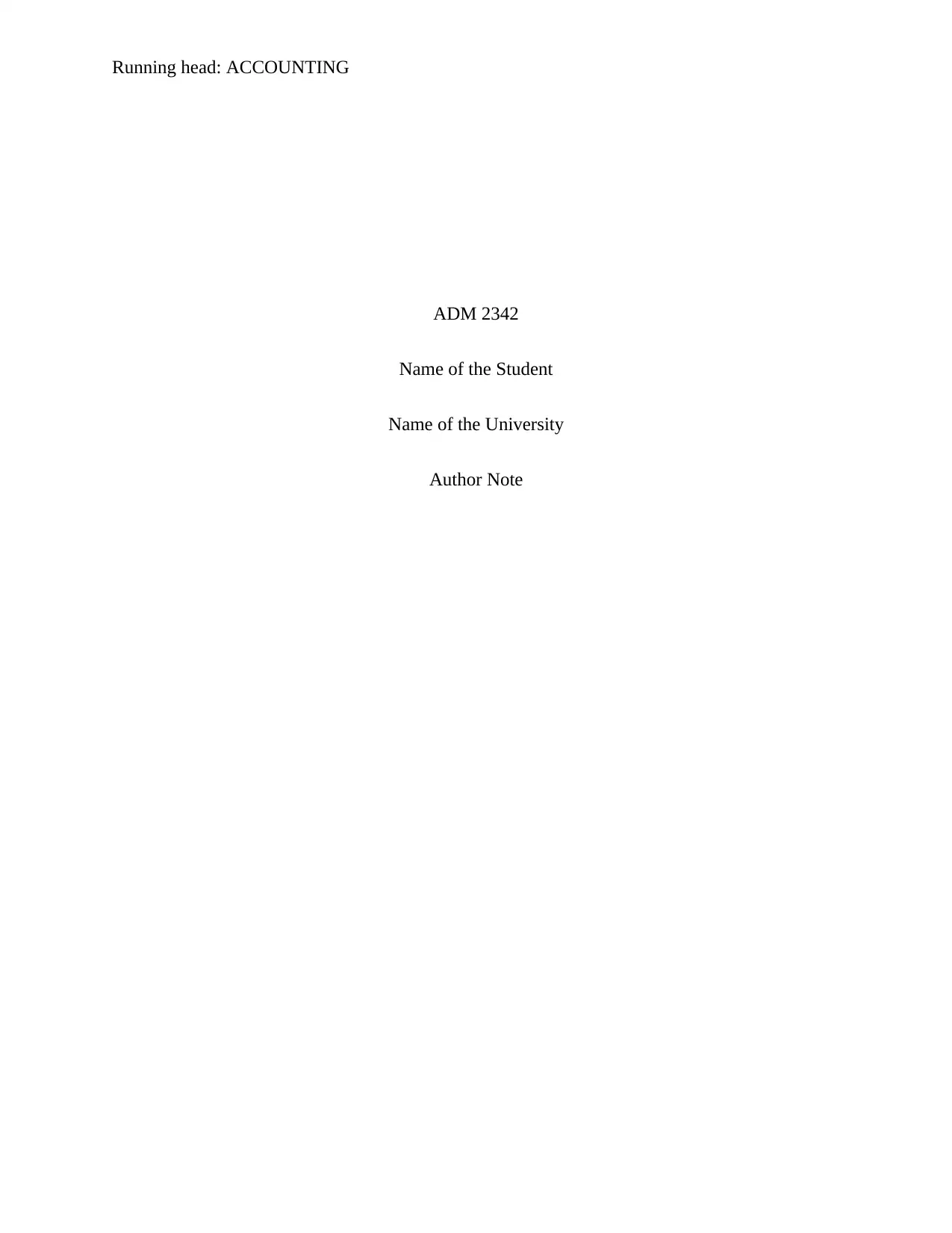
Running head: ACCOUNTING
ADM 2342
Name of the Student
Name of the University
Author Note
ADM 2342
Name of the Student
Name of the University
Author Note
Paraphrase This Document
Need a fresh take? Get an instant paraphrase of this document with our AI Paraphraser
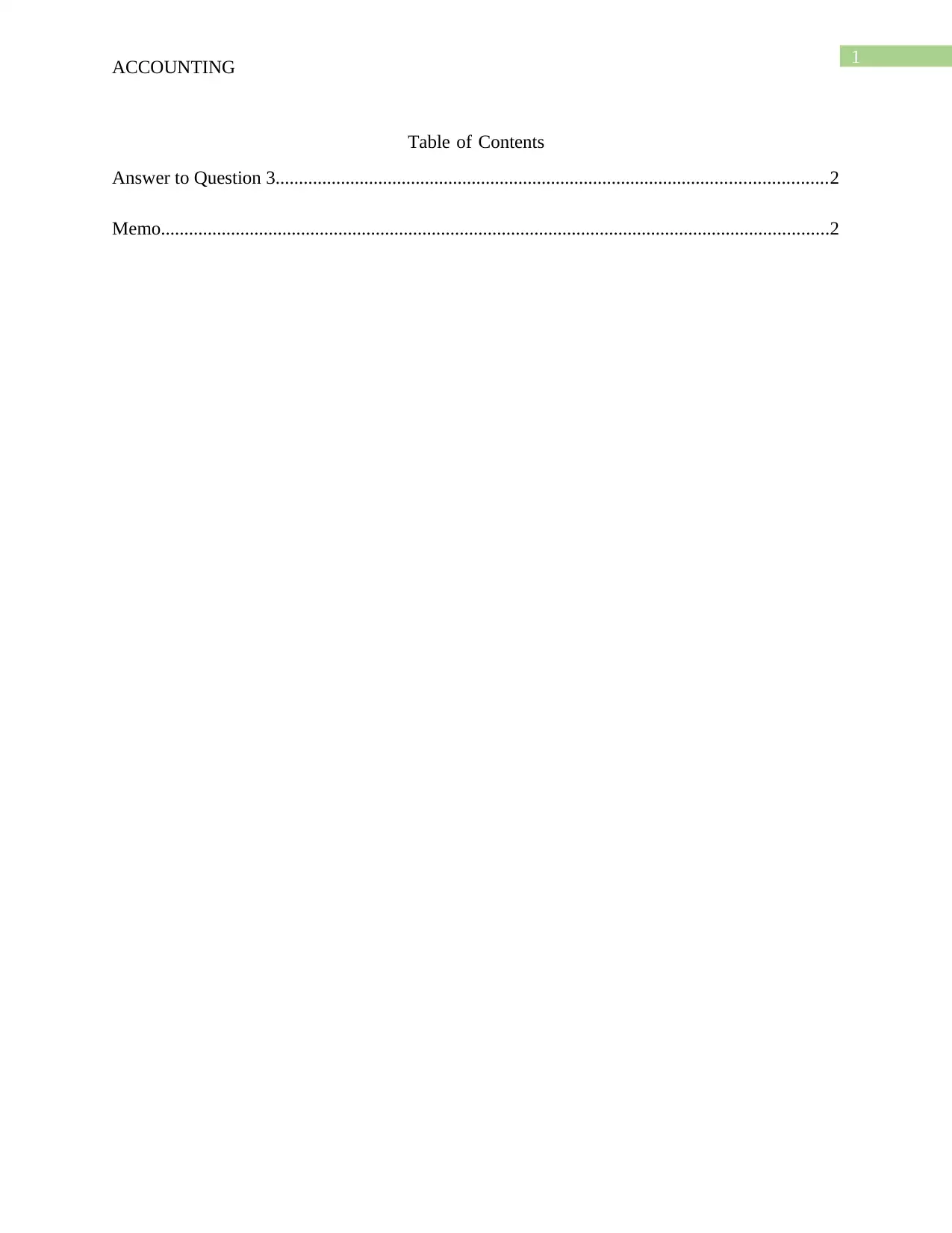
1
ACCOUNTING
Table of Contents
Answer to Question 3......................................................................................................................2
Memo...............................................................................................................................................2
ACCOUNTING
Table of Contents
Answer to Question 3......................................................................................................................2
Memo...............................................................................................................................................2
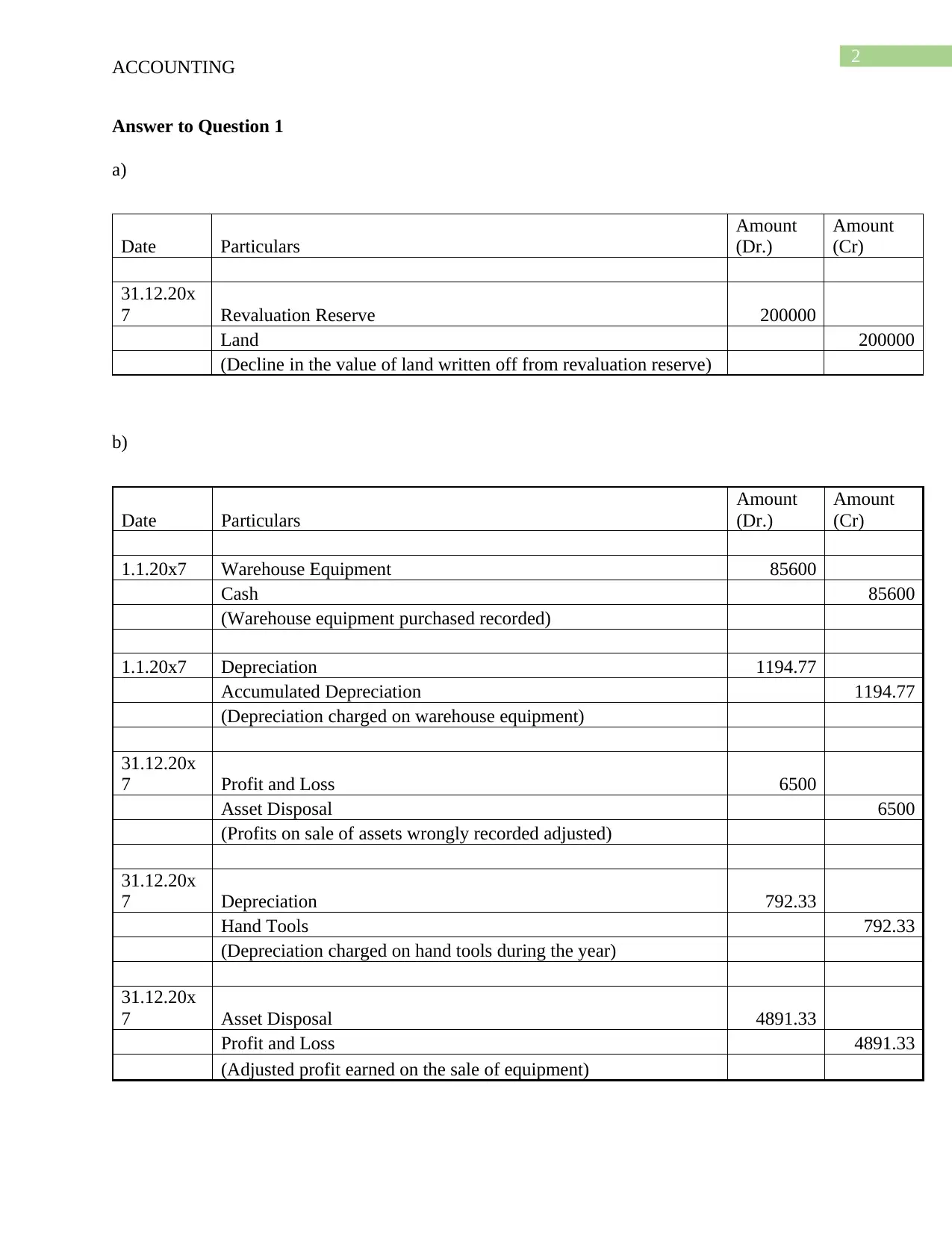
2
ACCOUNTING
Answer to Question 1
a)
Date Particulars
Amount
(Dr.)
Amount
(Cr)
31.12.20x
7 Revaluation Reserve 200000
Land 200000
(Decline in the value of land written off from revaluation reserve)
b)
Date Particulars
Amount
(Dr.)
Amount
(Cr)
1.1.20x7 Warehouse Equipment 85600
Cash 85600
(Warehouse equipment purchased recorded)
1.1.20x7 Depreciation 1194.77
Accumulated Depreciation 1194.77
(Depreciation charged on warehouse equipment)
31.12.20x
7 Profit and Loss 6500
Asset Disposal 6500
(Profits on sale of assets wrongly recorded adjusted)
31.12.20x
7 Depreciation 792.33
Hand Tools 792.33
(Depreciation charged on hand tools during the year)
31.12.20x
7 Asset Disposal 4891.33
Profit and Loss 4891.33
(Adjusted profit earned on the sale of equipment)
ACCOUNTING
Answer to Question 1
a)
Date Particulars
Amount
(Dr.)
Amount
(Cr)
31.12.20x
7 Revaluation Reserve 200000
Land 200000
(Decline in the value of land written off from revaluation reserve)
b)
Date Particulars
Amount
(Dr.)
Amount
(Cr)
1.1.20x7 Warehouse Equipment 85600
Cash 85600
(Warehouse equipment purchased recorded)
1.1.20x7 Depreciation 1194.77
Accumulated Depreciation 1194.77
(Depreciation charged on warehouse equipment)
31.12.20x
7 Profit and Loss 6500
Asset Disposal 6500
(Profits on sale of assets wrongly recorded adjusted)
31.12.20x
7 Depreciation 792.33
Hand Tools 792.33
(Depreciation charged on hand tools during the year)
31.12.20x
7 Asset Disposal 4891.33
Profit and Loss 4891.33
(Adjusted profit earned on the sale of equipment)
⊘ This is a preview!⊘
Do you want full access?
Subscribe today to unlock all pages.

Trusted by 1+ million students worldwide
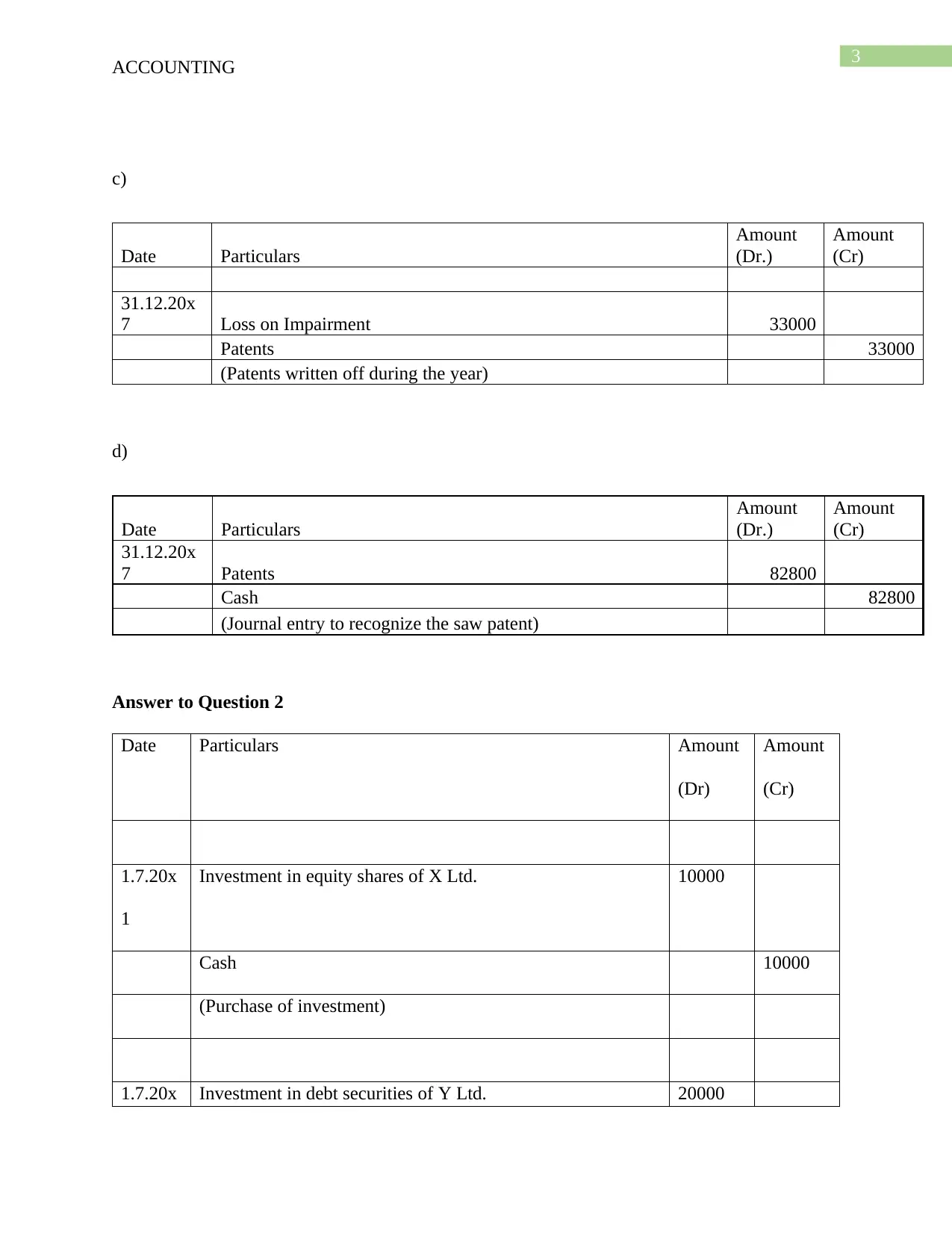
3
ACCOUNTING
c)
Date Particulars
Amount
(Dr.)
Amount
(Cr)
31.12.20x
7 Loss on Impairment 33000
Patents 33000
(Patents written off during the year)
d)
Date Particulars
Amount
(Dr.)
Amount
(Cr)
31.12.20x
7 Patents 82800
Cash 82800
(Journal entry to recognize the saw patent)
Answer to Question 2
Date Particulars Amount
(Dr)
Amount
(Cr)
1.7.20x
1
Investment in equity shares of X Ltd. 10000
Cash 10000
(Purchase of investment)
1.7.20x Investment in debt securities of Y Ltd. 20000
ACCOUNTING
c)
Date Particulars
Amount
(Dr.)
Amount
(Cr)
31.12.20x
7 Loss on Impairment 33000
Patents 33000
(Patents written off during the year)
d)
Date Particulars
Amount
(Dr.)
Amount
(Cr)
31.12.20x
7 Patents 82800
Cash 82800
(Journal entry to recognize the saw patent)
Answer to Question 2
Date Particulars Amount
(Dr)
Amount
(Cr)
1.7.20x
1
Investment in equity shares of X Ltd. 10000
Cash 10000
(Purchase of investment)
1.7.20x Investment in debt securities of Y Ltd. 20000
Paraphrase This Document
Need a fresh take? Get an instant paraphrase of this document with our AI Paraphraser
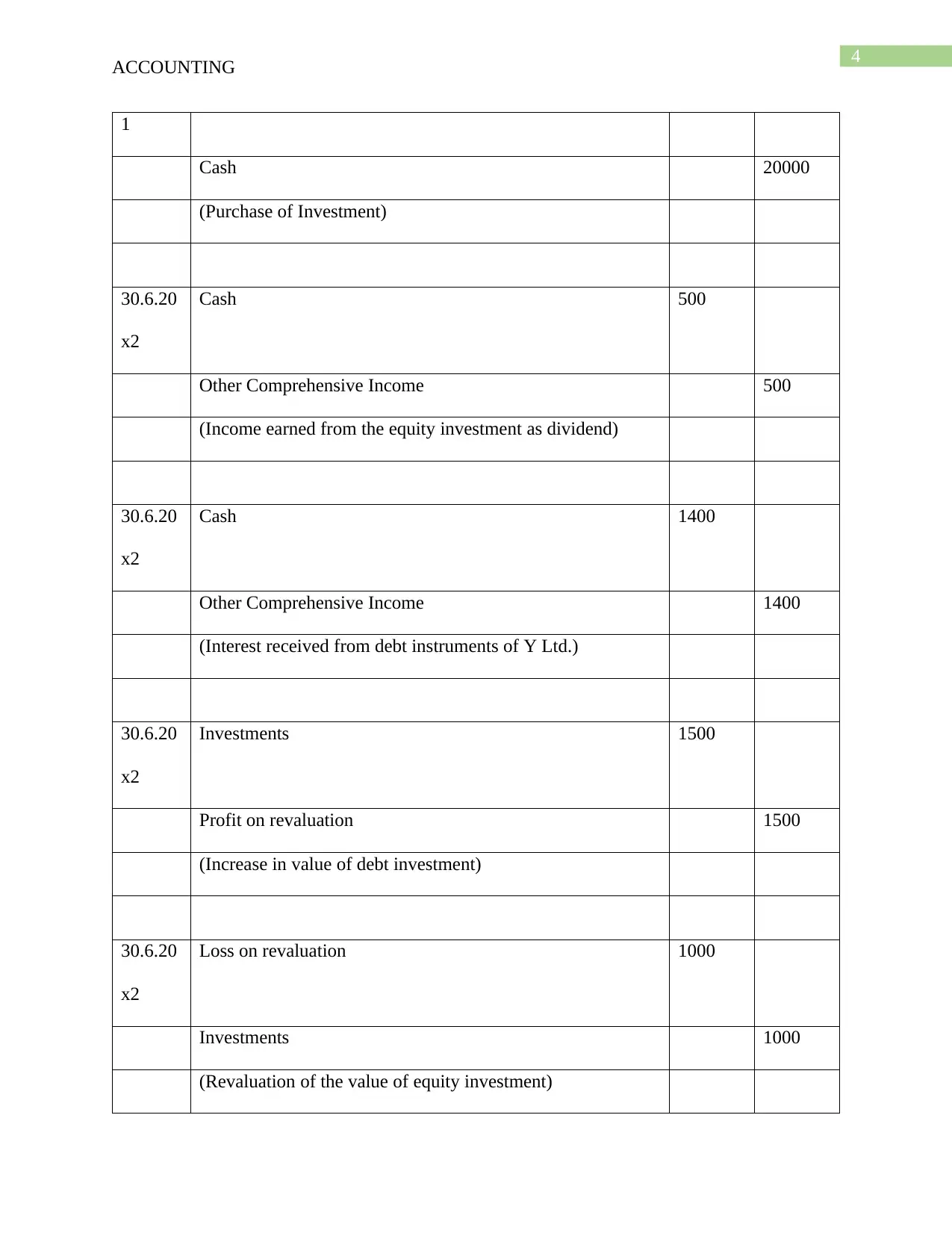
4
ACCOUNTING
1
Cash 20000
(Purchase of Investment)
30.6.20
x2
Cash 500
Other Comprehensive Income 500
(Income earned from the equity investment as dividend)
30.6.20
x2
Cash 1400
Other Comprehensive Income 1400
(Interest received from debt instruments of Y Ltd.)
30.6.20
x2
Investments 1500
Profit on revaluation 1500
(Increase in value of debt investment)
30.6.20
x2
Loss on revaluation 1000
Investments 1000
(Revaluation of the value of equity investment)
ACCOUNTING
1
Cash 20000
(Purchase of Investment)
30.6.20
x2
Cash 500
Other Comprehensive Income 500
(Income earned from the equity investment as dividend)
30.6.20
x2
Cash 1400
Other Comprehensive Income 1400
(Interest received from debt instruments of Y Ltd.)
30.6.20
x2
Investments 1500
Profit on revaluation 1500
(Increase in value of debt investment)
30.6.20
x2
Loss on revaluation 1000
Investments 1000
(Revaluation of the value of equity investment)
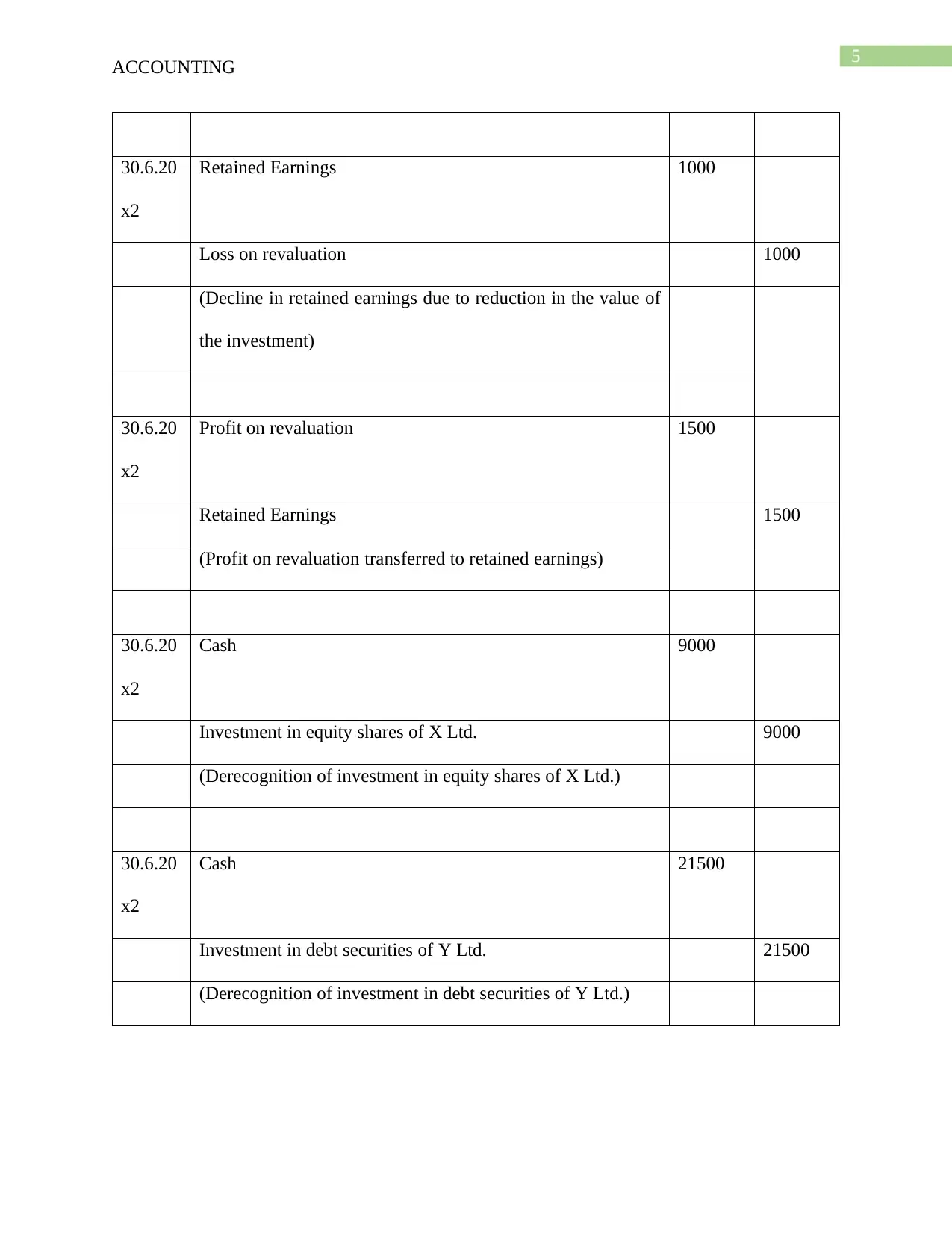
5
ACCOUNTING
30.6.20
x2
Retained Earnings 1000
Loss on revaluation 1000
(Decline in retained earnings due to reduction in the value of
the investment)
30.6.20
x2
Profit on revaluation 1500
Retained Earnings 1500
(Profit on revaluation transferred to retained earnings)
30.6.20
x2
Cash 9000
Investment in equity shares of X Ltd. 9000
(Derecognition of investment in equity shares of X Ltd.)
30.6.20
x2
Cash 21500
Investment in debt securities of Y Ltd. 21500
(Derecognition of investment in debt securities of Y Ltd.)
ACCOUNTING
30.6.20
x2
Retained Earnings 1000
Loss on revaluation 1000
(Decline in retained earnings due to reduction in the value of
the investment)
30.6.20
x2
Profit on revaluation 1500
Retained Earnings 1500
(Profit on revaluation transferred to retained earnings)
30.6.20
x2
Cash 9000
Investment in equity shares of X Ltd. 9000
(Derecognition of investment in equity shares of X Ltd.)
30.6.20
x2
Cash 21500
Investment in debt securities of Y Ltd. 21500
(Derecognition of investment in debt securities of Y Ltd.)
⊘ This is a preview!⊘
Do you want full access?
Subscribe today to unlock all pages.

Trusted by 1+ million students worldwide
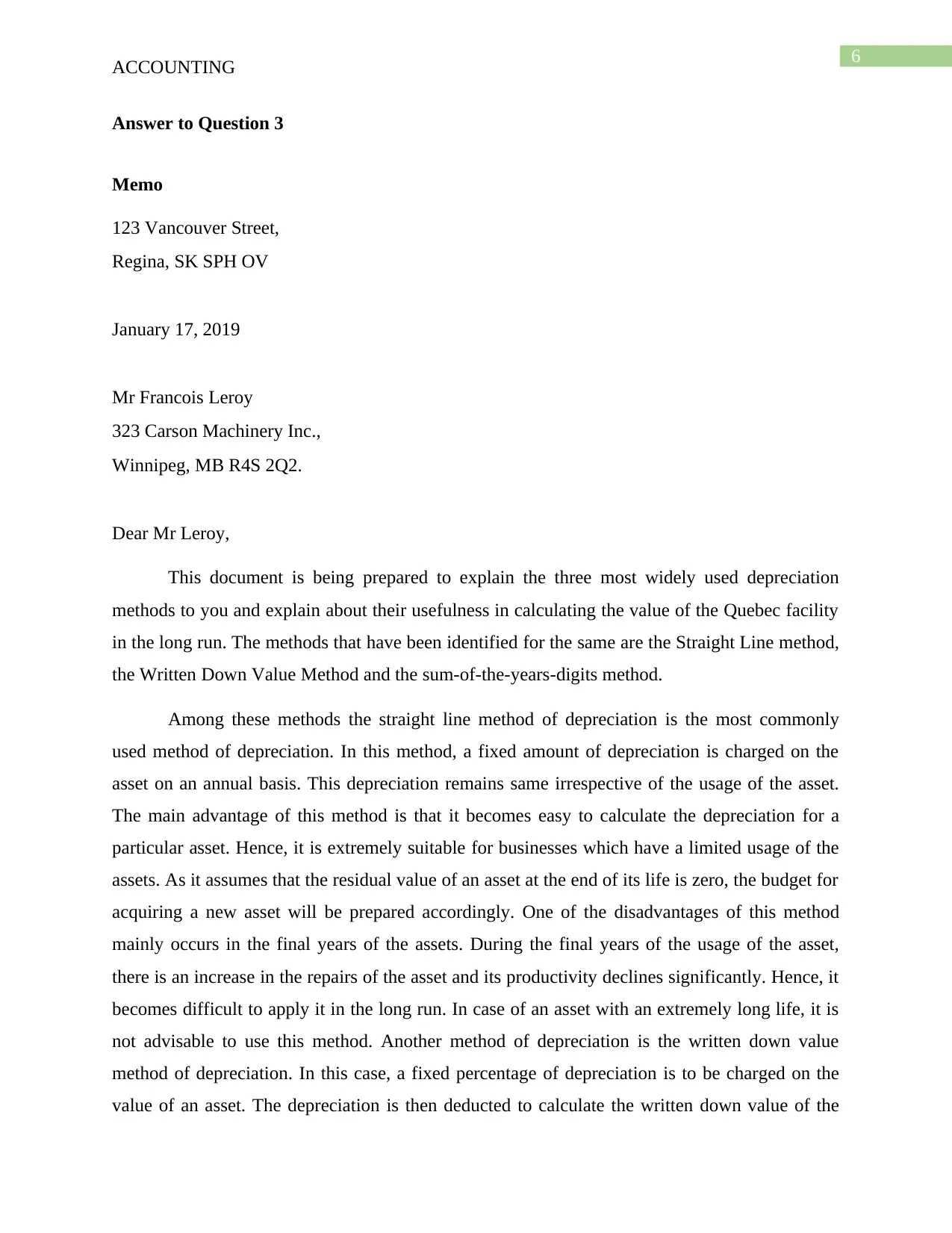
6
ACCOUNTING
Answer to Question 3
Memo
123 Vancouver Street,
Regina, SK SPH OV
January 17, 2019
Mr Francois Leroy
323 Carson Machinery Inc.,
Winnipeg, MB R4S 2Q2.
Dear Mr Leroy,
This document is being prepared to explain the three most widely used depreciation
methods to you and explain about their usefulness in calculating the value of the Quebec facility
in the long run. The methods that have been identified for the same are the Straight Line method,
the Written Down Value Method and the sum-of-the-years-digits method.
Among these methods the straight line method of depreciation is the most commonly
used method of depreciation. In this method, a fixed amount of depreciation is charged on the
asset on an annual basis. This depreciation remains same irrespective of the usage of the asset.
The main advantage of this method is that it becomes easy to calculate the depreciation for a
particular asset. Hence, it is extremely suitable for businesses which have a limited usage of the
assets. As it assumes that the residual value of an asset at the end of its life is zero, the budget for
acquiring a new asset will be prepared accordingly. One of the disadvantages of this method
mainly occurs in the final years of the assets. During the final years of the usage of the asset,
there is an increase in the repairs of the asset and its productivity declines significantly. Hence, it
becomes difficult to apply it in the long run. In case of an asset with an extremely long life, it is
not advisable to use this method. Another method of depreciation is the written down value
method of depreciation. In this case, a fixed percentage of depreciation is to be charged on the
value of an asset. The depreciation is then deducted to calculate the written down value of the
ACCOUNTING
Answer to Question 3
Memo
123 Vancouver Street,
Regina, SK SPH OV
January 17, 2019
Mr Francois Leroy
323 Carson Machinery Inc.,
Winnipeg, MB R4S 2Q2.
Dear Mr Leroy,
This document is being prepared to explain the three most widely used depreciation
methods to you and explain about their usefulness in calculating the value of the Quebec facility
in the long run. The methods that have been identified for the same are the Straight Line method,
the Written Down Value Method and the sum-of-the-years-digits method.
Among these methods the straight line method of depreciation is the most commonly
used method of depreciation. In this method, a fixed amount of depreciation is charged on the
asset on an annual basis. This depreciation remains same irrespective of the usage of the asset.
The main advantage of this method is that it becomes easy to calculate the depreciation for a
particular asset. Hence, it is extremely suitable for businesses which have a limited usage of the
assets. As it assumes that the residual value of an asset at the end of its life is zero, the budget for
acquiring a new asset will be prepared accordingly. One of the disadvantages of this method
mainly occurs in the final years of the assets. During the final years of the usage of the asset,
there is an increase in the repairs of the asset and its productivity declines significantly. Hence, it
becomes difficult to apply it in the long run. In case of an asset with an extremely long life, it is
not advisable to use this method. Another method of depreciation is the written down value
method of depreciation. In this case, a fixed percentage of depreciation is to be charged on the
value of an asset. The depreciation is then deducted to calculate the written down value of the
Paraphrase This Document
Need a fresh take? Get an instant paraphrase of this document with our AI Paraphraser
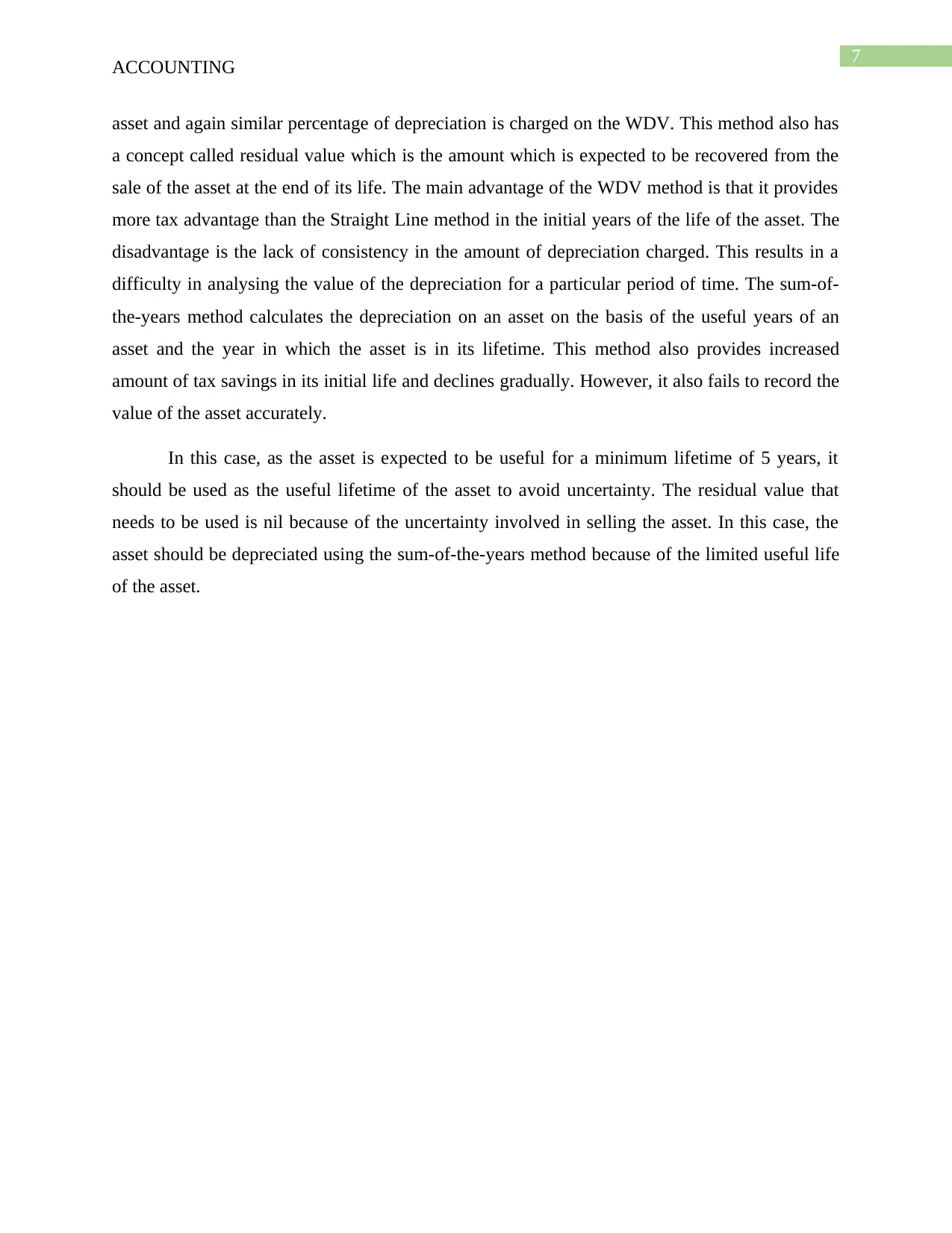
7
ACCOUNTING
asset and again similar percentage of depreciation is charged on the WDV. This method also has
a concept called residual value which is the amount which is expected to be recovered from the
sale of the asset at the end of its life. The main advantage of the WDV method is that it provides
more tax advantage than the Straight Line method in the initial years of the life of the asset. The
disadvantage is the lack of consistency in the amount of depreciation charged. This results in a
difficulty in analysing the value of the depreciation for a particular period of time. The sum-of-
the-years method calculates the depreciation on an asset on the basis of the useful years of an
asset and the year in which the asset is in its lifetime. This method also provides increased
amount of tax savings in its initial life and declines gradually. However, it also fails to record the
value of the asset accurately.
In this case, as the asset is expected to be useful for a minimum lifetime of 5 years, it
should be used as the useful lifetime of the asset to avoid uncertainty. The residual value that
needs to be used is nil because of the uncertainty involved in selling the asset. In this case, the
asset should be depreciated using the sum-of-the-years method because of the limited useful life
of the asset.
ACCOUNTING
asset and again similar percentage of depreciation is charged on the WDV. This method also has
a concept called residual value which is the amount which is expected to be recovered from the
sale of the asset at the end of its life. The main advantage of the WDV method is that it provides
more tax advantage than the Straight Line method in the initial years of the life of the asset. The
disadvantage is the lack of consistency in the amount of depreciation charged. This results in a
difficulty in analysing the value of the depreciation for a particular period of time. The sum-of-
the-years method calculates the depreciation on an asset on the basis of the useful years of an
asset and the year in which the asset is in its lifetime. This method also provides increased
amount of tax savings in its initial life and declines gradually. However, it also fails to record the
value of the asset accurately.
In this case, as the asset is expected to be useful for a minimum lifetime of 5 years, it
should be used as the useful lifetime of the asset to avoid uncertainty. The residual value that
needs to be used is nil because of the uncertainty involved in selling the asset. In this case, the
asset should be depreciated using the sum-of-the-years method because of the limited useful life
of the asset.
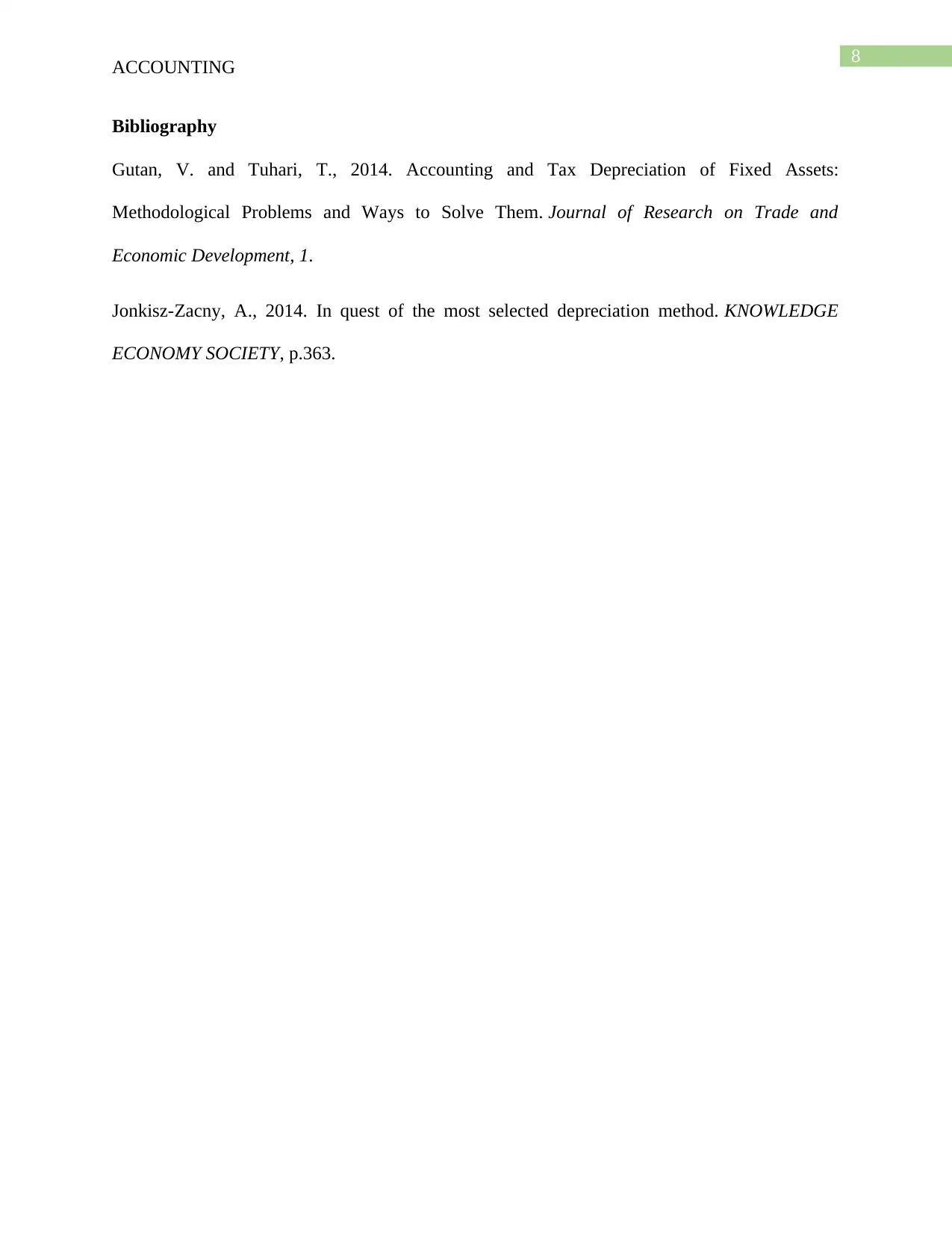
8
ACCOUNTING
Bibliography
Gutan, V. and Tuhari, T., 2014. Accounting and Tax Depreciation of Fixed Assets:
Methodological Problems and Ways to Solve Them. Journal of Research on Trade and
Economic Development, 1.
Jonkisz-Zacny, A., 2014. In quest of the most selected depreciation method. KNOWLEDGE
ECONOMY SOCIETY, p.363.
ACCOUNTING
Bibliography
Gutan, V. and Tuhari, T., 2014. Accounting and Tax Depreciation of Fixed Assets:
Methodological Problems and Ways to Solve Them. Journal of Research on Trade and
Economic Development, 1.
Jonkisz-Zacny, A., 2014. In quest of the most selected depreciation method. KNOWLEDGE
ECONOMY SOCIETY, p.363.
⊘ This is a preview!⊘
Do you want full access?
Subscribe today to unlock all pages.

Trusted by 1+ million students worldwide
1 out of 9
Related Documents
Your All-in-One AI-Powered Toolkit for Academic Success.
+13062052269
info@desklib.com
Available 24*7 on WhatsApp / Email
![[object Object]](/_next/static/media/star-bottom.7253800d.svg)
Unlock your academic potential
Copyright © 2020–2025 A2Z Services. All Rights Reserved. Developed and managed by ZUCOL.





